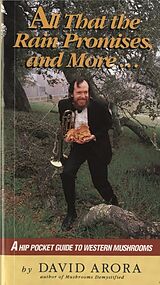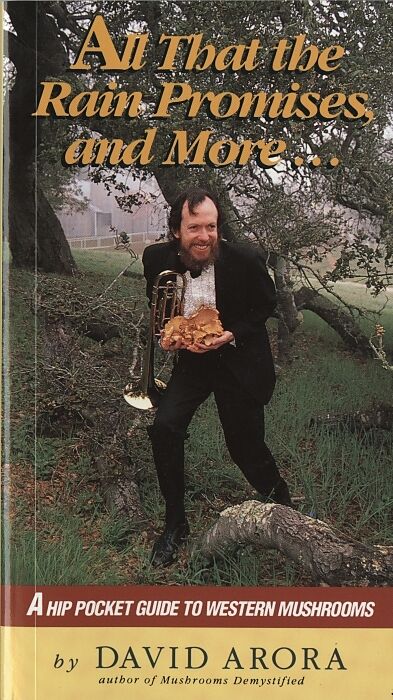All That the Rain Promises and More
Einband:
Broschiert
EAN:
9780898153880
Untertitel:
A Hip Pocket Guide to Western Mushrooms
Genre:
Natur, Garten & Tiere
Autor:
David Arora
Herausgeber:
Random House N.Y.
Anzahl Seiten:
288
Erscheinungsdatum:
01.02.1991
ISBN:
0898153883
Zusatztext "[ All That the Rain Promises and More ] is certainly the best guide to fungi! and may in fact be a long lasting masterpiece in guide writing for all subjects." - Roger McKnight! New York Times Informationen zum Autor David Arora Klappentext An illustrated guide to identifying 200 Western mushrooms - whether edible, poisonous, or medicinal - by their key features. "In leafing through these pages, you may wonder what all the 'fanciful,' 'foolish,' or (shudder) 'extraneous' material is doing in a factual guide. After all, it is the practical, hands-on, how-to-identify information that makes this book useful and gives it substance. But I ask: is it any stranger or less desirable to sprinkle the facts with flakes of fancy than it is to liven up solemn, substantial fare like potatoes with something fancier and more flavorful, like wild mushrooms?" - David Arora "[All That the Rain Promises and More] is certainly the best guide to fungi, and may in fact be a long lasting masterpiece in guide writing for all subjects." - Roger McKnight, New York Times Leseprobe Introduction Mushrooms are the reproductive structures or "fruit" of certain fungi. The most familiar kind of mushroom has a cap with gills (radiating blades) on its underside. Millions of microscopic reproductive units called spores are discharged from the gills and dispersed by air currents. Only a small percentage of spores land in a favorable environment, where they germinate to form new fungi. Fungi do not manufacture their own food like plants. In this respect they are like animals: they must obtain food from outside sources. The part of the mushroom fungus that digests nutrients is an intricate web of fine threads collectively called the mycelium (plural: mycelia). The mycelium may live anywhere from a few days (in perishable substrates like dung) to several hundred years, periodically producing mushrooms when enough moisture is available. Mushrooms, or more exactly the fungi that produce them, are a vital and omnipresent part of our environment. Despite their bad press, the overwhelming majority are beneficial. A few are parasitic , feeding on living organisms, usually trees. The rest are either saprophytic or mycorrhizal. Saprophytic fungi are nature's recyclers. They replenish the soil by breaking down complex organic matter (wood, dung, humus, etc.) into simpler, reusable compounds. Mycorrhizal fungi form a mutually beneficial relationship with the rootlets of plants in which nutrients are exchanged. They are critical to the health of our forests, as many trees will not grow without them. (Since some mycorrhizal mushrooms are associated with certain kinds of trees, make a habit of noting the different trees growing in the vicinity of any mushroom you wish to identify.) Despite the many benefits and uses of mushrooms, most North Americans are markedly fungophobic , a trait inherited from the British. Fungophobia can be defined as the belief that mushrooms are actively hostile at worst and worthless at best. It is only in the last few years that large numbers of North Americans have begun to discover what the mushroom-loving peoples of Japan, China, Russia, and Europe have known for centuries: that these "forbidden fruit" are delicious and nutritious, vital and valuable, potent and beautiful, and that mushroom hunting is a challenging, enlightening, and uplifting activity. How To Use This Book Simple. Once you've collected a distinctive mushroom, consult the quick key to mushroom groups on the inside front and back covers, and go to the section of the book indicated. Flip through the pictures in that section until you find one that looks similar to your mushroom. Then carefully go through the numbered list of "Key Features" on that page, checking them off as yo...
"[All That the Rain Promises and More] is certainly the best guide to fungi, and may in fact be a long lasting masterpiece in guide writing for all subjects." - Roger McKnight, New York Times
Autorentext
David Arora
Klappentext
An illustrated guide to identifying 200 Western mushrooms - whether edible, poisonous, or medicinal - by their key features.
"In leafing through these pages, you may wonder what all the 'fanciful,' 'foolish,' or (shudder) 'extraneous' material is doing in a factual guide. After all, it is the practical, hands-on, how-to-identify information that makes this book useful and gives it substance. But I ask: is it any stranger or less desirable to sprinkle the facts with flakes of fancy than it is to liven up solemn, substantial fare like potatoes with something fancier and more flavorful, like wild mushrooms?" - David Arora
"[All That the Rain Promises and More] is certainly the best guide to fungi, and may in fact be a long lasting masterpiece in guide writing for all subjects." - Roger McKnight, New York Times
Leseprobe
Introduction
Mushrooms are the reproductive structures or "fruit" of certain fungi. The most familiar kind of mushroom has a cap with gills (radiating blades) on its underside. Millions of microscopic reproductive units called spores are discharged from the gills and dispersed by air currents. Only a small percentage of spores land in a favorable environment, where they germinate to form new fungi.
Fungi do not manufacture their own food like plants. In this respect they are like animals: they must obtain food from outside sources. The part of the mushroom fungus that digests nutrients is an intricate web of fine threads collectively called the mycelium (plural: mycelia). The mycelium may live anywhere from a few days (in perishable substrates like dung) to several hundred years, periodically producing mushrooms when enough moisture is available.
Mushrooms, or more exactly the fungi that produce them, are a vital and omnipresent part of our environment. Despite their bad press, the overwhelming majority are beneficial. A few are parasitic, feeding on living organisms, usually trees. The rest are either saprophytic or mycorrhizal. Saprophytic fungi are nature's recyclers. They replenish the soil by breaking down complex organic matter (wood, dung, humus, etc.) into simpler, reusable compounds. Mycorrhizal fungi form a mutually beneficial relationship with the rootlets of plants in which nutrients are exchanged. They are critical to the health of our forests, as many trees will not grow without them. (Since some mycorrhizal mushrooms are associated with certain kinds of trees, make a habit of noting the different trees growing in the vicinity of any mushroom you wish to identify.)
Despite the many benefits and uses of mushrooms, most North Americans are markedly fungophobic, a trait inherited from the British. Fungophobia can be defined as the belief that mushrooms are actively hostile at worst and worthless at best. It is only in the last few years that large numbers of North Americans have begun to discover what the mushroom-loving peoples of Japan, China, Russia, and Europe have known for centuries: that these "forbidden fruit" are delicious and nutritious, vital and valuable, potent and beautiful, and that mushroom hunting is a challenging, enlightening, and uplifting activity.
How To Use This Book
Simple. Once you've collected a distinctive mushroom, consult the quick key to mushroom groups on the inside front and back covers, and go to the section of the book indicated. Flip through the pictures in that section until you find one that looks similar to your mushroom. Then carefully go through the numbered list of "Key Features" on that page, checking them off as you go so you don't inadvertently miss one. If your mushroom has all of the key features, then you have identified it! To verify your identification, check the details…

Leider konnten wir für diesen Artikel keine Preise ermitteln ...
billigbuch.ch sucht jetzt für Sie die besten Angebote ...
Die aktuellen Verkaufspreise von 6 Onlineshops werden in Realtime abgefragt.
Sie können das gewünschte Produkt anschliessend direkt beim Anbieter Ihrer Wahl bestellen.
Loading...
Die aktuellen Verkaufspreise von 6 Onlineshops werden in Realtime abgefragt.
Sie können das gewünschte Produkt anschliessend direkt beim Anbieter Ihrer Wahl bestellen.
| # | Onlineshop | Preis CHF | Versand CHF | Total CHF | ||
|---|---|---|---|---|---|---|
| 1 | Seller | 0.00 | 0.00 | 0.00 |
